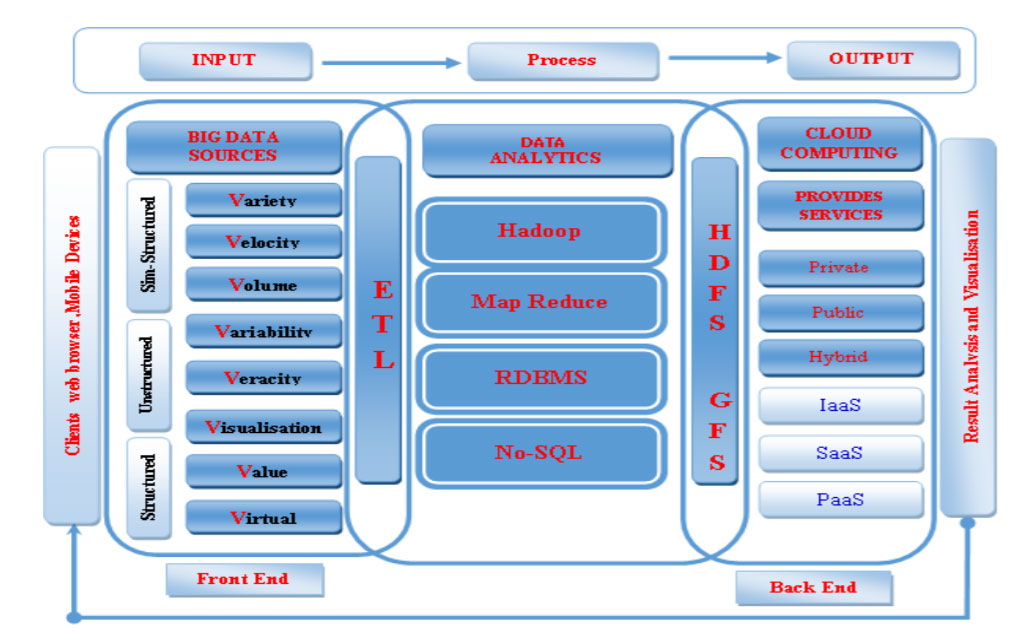Communicating through Information Technology produces large amounts of data. This data will need processing and storage. This is where cloud storage comes into play, here, the data is stored on multiple virtual servers.
The processing of big data showcases a new challenge in computing, particularly in cloud computing. This article describes the relationship between cloud computing and big data. And, also discusses the processing of big data in cloud computing.

Big data.
Data is considered as the raw material for information before it gets sorted, arranged and processed. It cannot be used in its actual form (before processing), the information represents the data which is processed and analyzed. The technology has slowly advanced in many aspects of life and increased the demand for preserving and processing of large data.
As a result, many systems have been developed, such as cloud computing to support big data. The cloud is capable of providing a scalable, accessible and reliable environment for big data systems to function. Big data is described as the amount of digital data produced from various sources of technology, for example, digitizers, sensors, numerical modeling, internet, mobiles, e-mails, videos, and social networks. The data is of various types like images, text, geometrics, sounds, videos, and a combination of each.
The big data is extracted from various sources and exists in different forms:
- Structured Data: This type of data exists in the form of databases and tables to be processed.
- Unstructured Data: It represents a large proportion of data, it exists in the form of log records, videos, images and clicks streams.
| Metrics | Traditional Data | Big Data |
|---|---|---|
| Volume | MB or GB | PB’s and ZB’s |
| Data Generation Rate | Long Period of Time | More Rapid |
| Data Type | Structured | Sim-Structured, Unstructured |
| Data Source | Centralized | Multiple Sources, Distributed |
| Data Storage | RDBMS | NoSQL, HDFS |
Table representing the difference between traditional data and big data.
Cloud computing.
Cloud computing is described as on-demand computing resources and systems spread throughout the network that can offer a number of integrated computing services restricting local resources to facilitate user access.
These resources contain backup, data storage capacity and self-synchronization. Most of the IT Infrastructure computing have services that are offered and delivered through public centers and servers based on them.
Cloud computing is one of the distributed systems that showcases a sophisticated representational model. The National Institute of Standards and Technology(NIST) has identified some of the important aspects of cloud and listed the characteristics of cloud computing as shown below:
- On-demand self-service
- Broad network access
- Measured service
- Rapid Elasticity
- Resource Pooling
Relation between big data and cloud computing.
The relation between big data and cloud computing is particularly based on integration, where the cloud is the storehouse and big data is the product stored in it since it is difficult to create storehouses without storing any product in them.
The traditional databases also known as relational are no longer sufficient to process multiple-source data. For instance, how can these traditional methods comply with data such as customer behavior, a record of transactions and GPS navigation? At this point, the relationship between cloud computing and big data will arise.

Image showing the relationship between Big Data And Cloud Computing
Various factors influencing big data:
Cloud storage.
Cloud storage is similar to that of storing files on a distant server to pull them from multiple devices when required. Cloud storage is basically a system that enables users to store data on the internet. Examples of cloud storage systems are google drive, Dropbox.
Cloud storage is for storing information and cloud computing is for completing specified digital tasks. In many applications of cloud computing, data is sent to distant processors via the internet for complete operation, and the resulting data is returned. Cloud computing is highly useful for large enterprises than individuals in most applications of cloud computing.
The data is continuously increasing and it requires equipment to store them. The cloud provides storage units, making it simple to navigate without the need to carry in physical storage types of equipment. The limited data storage is a real concern, with cloud, the data can be stored easily through a cloud service provider (CSP) in a group of cloud servers. The users interact with the cloud servers through CSP to retrieve or access the data.
Database management system.
The data is gathered in the form of an organized way known as the database which is the necessity for any information system. Data in huge amounts is the major component of the cloud infrastructure. It can be shared among many tenants. Hence, data management is a key aspect of data storage in the cloud. Data is distributed across multiple sites in the cloud and may contain specific privileges and authentic data.
Big data and cloud computing are complementary to each other. Growth of big data at a faster pace is considered a big problem. Clouds are transforming and offering solutions for the appropriate environment of big data while storing data in traditional form cannot meet the requirements for dealing with big data.
The cloud computing environment is expanding to be able to absorb big amounts of data as it follows the policy of data splitting, that is, to store data in more than one location or area available. Cloud computing environments are built for general purpose workloads and resource pooling is used to provide flexibility on demand.
Conclusion.
Cloud computing and big data have been observed from many important aspects, and in this article, it has been concluded that the relation between them is complimentary. They both constitute an integrated model in the world of distributed network technology.
Leave a Reply